Dependency Injection
How Dependency Injection resolves object resolution cleanly

Introduction
I’m finally done kicking the object resolution can down the road. This wraps up the Essential Design Patterns.
About a dozen years ago, I worked on a tightly knit small team. I wrote some of the best code of my career while on that team. It just wasn’t the team that was tight. Our code was tightly coupled as well. It was modular, but it was still tightly coupled.
Often when we needed to test new behavior, we’d compile the entire product on our desktop machines, copy the executable to a thumb drive, walk it into our QA lab, copy the executable from the thumb drive to a server and then try to observe the new or updated functionality through the user interface.
If the behavior was broad, then we could probably observe it. If the behavior was more subtle, then we probably couldn’t observe it. Edge cases were very difficult to confirm. We’d ship our code and hope for the best. I don’t recall any major issues with what we wrote.
We had CppUnit, which is the C++ version of xUnit. We could write tests in CppUnit, but we didn’t really understand how to structure tests well. I tried writing CppUnit tests several times, but after a few weeks, they would start breaking, because they were brittle. It was several years before I figured out unit testing.
Some of my code was decoupled enough that I could test it on my desktop. I could test the sunny day scenarios, but I was having a real problem testing the rainy-day scenarios. For example, I wanted to confirm that my code handled an Exception correctly, but I couldn’t make the code throw an Exception easily.
I had been using Design Patterns for about 7 years by this point. What was I missing? Here’s an extremely high-level sketch of my basic design. Keep in mind that I want to confirm the expected behavior in ClientApplication when it calls myInterface.doThis() and an Exception is thrown by MyClass. But I couldn’t figure out a way to force MyClass to throw the Exception.
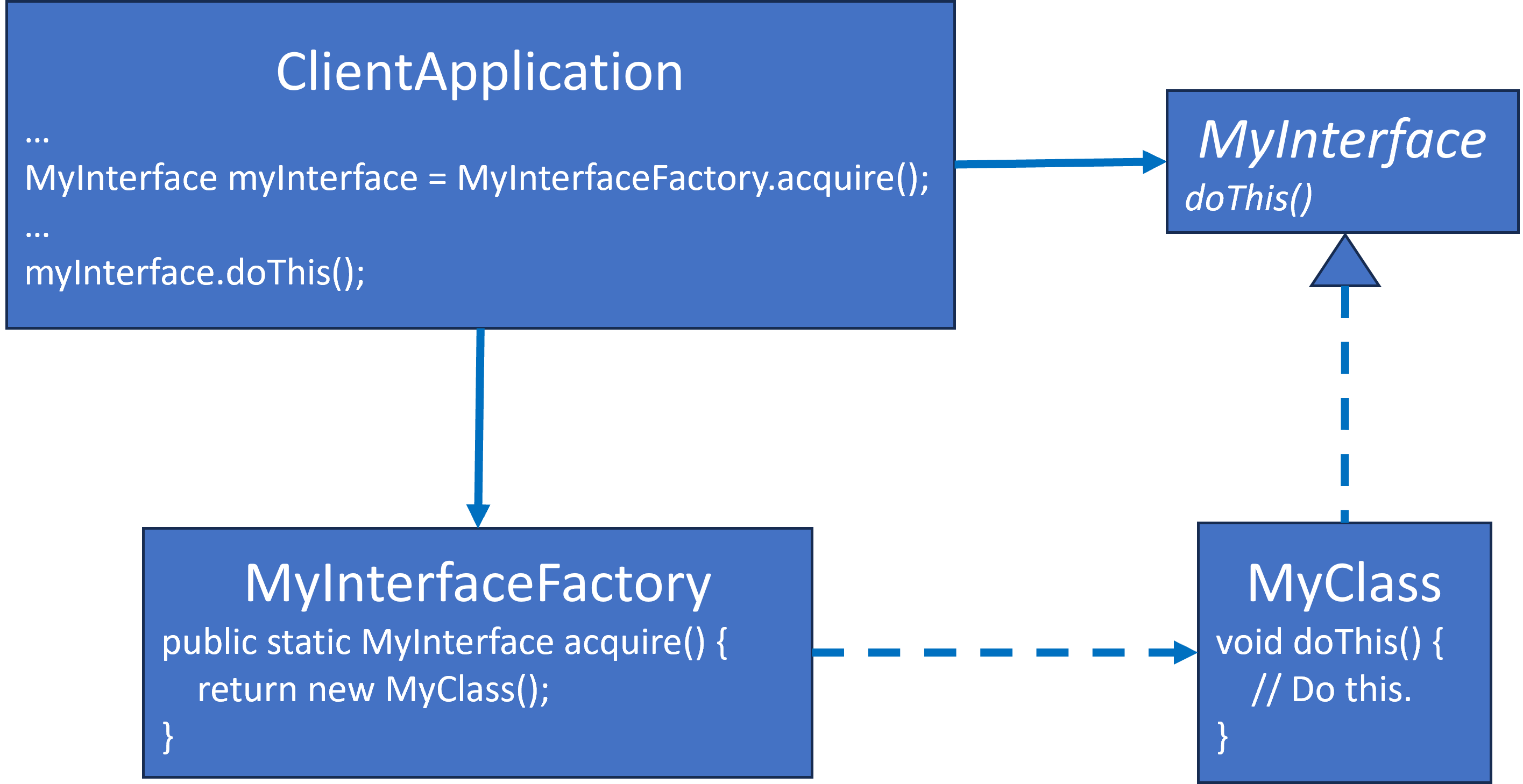
Why am I having this problem? I’m following good Design Pattern Principles:
- I’m programming to an interface, not an implementation.
- I’m encapsulating the implementation,
MyClass, fromClientApplicationby acquiring it via a Factory.
I figured out a way to force an Exception, but it was nasty:
- I created a new class,
MyTestDouble, which threw the Exception whendoThis()was called. - I would change the implementation in
MyInterfaceFactoryto return an instance ofMyTestDouble. - I would confirm the behavior via a manual test.
- I would change
MyInterfaceFactoryback to its original implementation to returnMyClass.
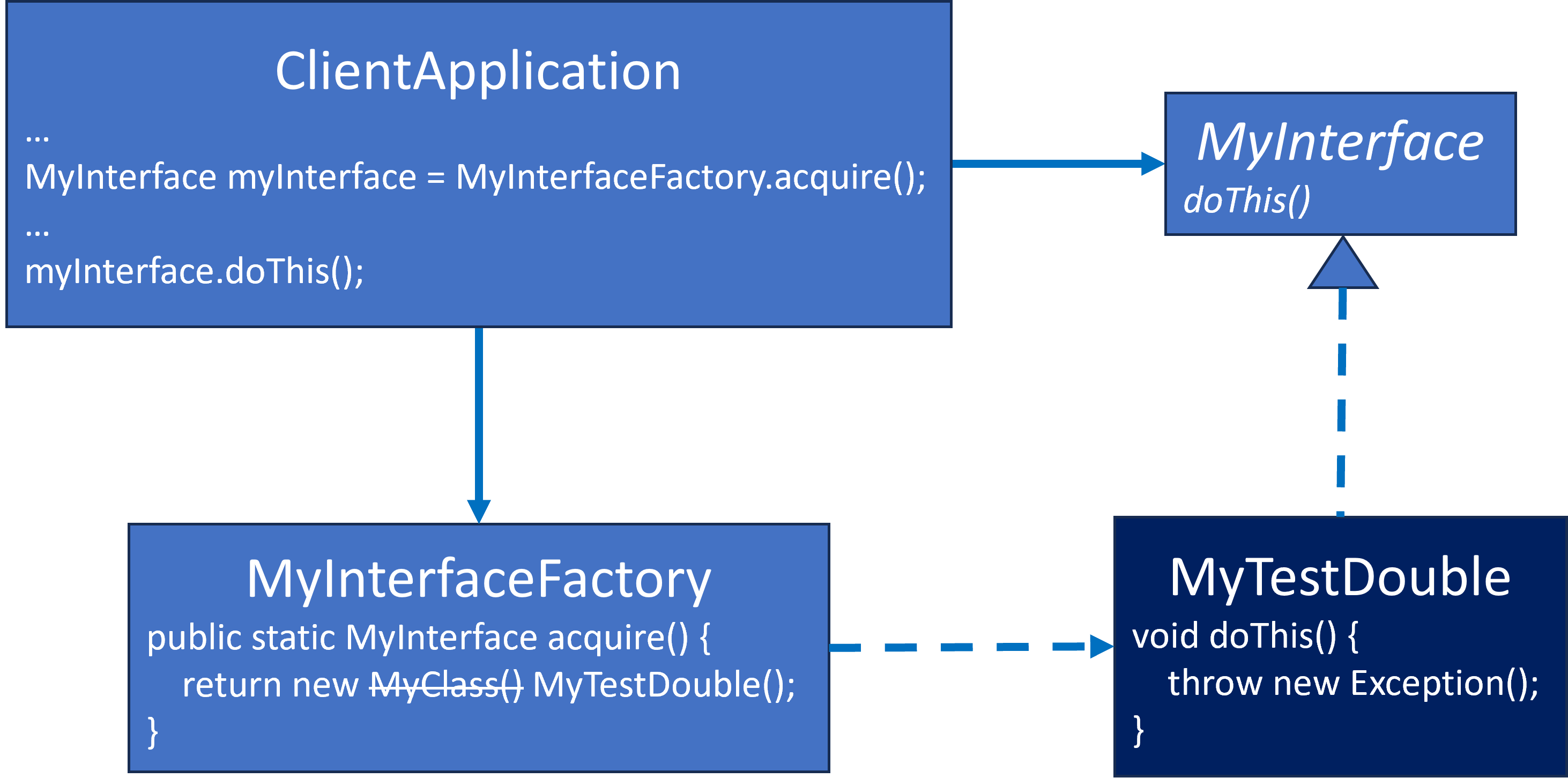
This worked, but it was painful. A test took a long time to set up and it required a change to the Factory. What if I ever forgot to revert the Factory back to its proper implementation?
Dependency Inversion Principle
What was I doing wrong?
I was violating the Dependency Inversion Principle (DIP), even though I had not heard of it before.
When code instantiates an object directly via new(), it is tightly coupled to that class. If the coupled class does the same, then it’s tightly coupled to its dependencies. This tight coupling can daisy chain through the system to the point that the entire system is tightly coupled from top to bottom. You can see how the arrows show dependency from left to right:

Programming to an interface, not an implementation helps break that dependency. Placing an interface between classes acts as a buffer that inverts the dependency. Notice that the interface implementation points up to the Implementation. It flips the dependency flow as seen above. It inverts the dependency.
The classes only depend upon interfaces. They don’t depend upon each other. They don’t even know about each other.
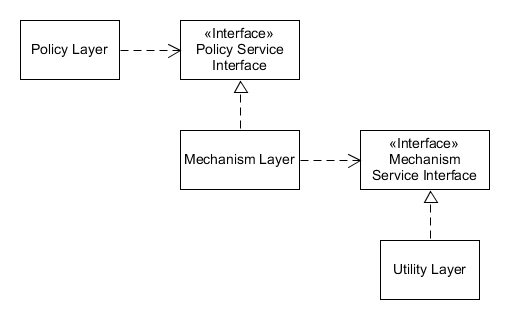
But this only part of the story. We inverted the dependencies in our project, mostly. I inverted the dependencies in my code, mostly. Yet the code was still coupled. Notice above that there are two potential paths from ClientApplication to MyClass.

One path is across the top and then down. That path is inverted, and not the problem. The second path is down and across the bottom. That one is the problem. Follow the arrows. There’s a dependency chain from ClientApplication to MyInterfaceFactory to MyClass in the object resolution. ClientApplication still depends upon MyClass, but it’s just not quite as obvious. I had not inverted all the dependencies.
Dependency Injection

At about that same time, I was reading Martin Reddy’s API Design for C++ I think this was one of the first times I had heard of Dependency Injection (DI). Here is some of what he wrote:
Dependency injection is a technique where an object is passed into a class (injected) instead of having the class create and store the object itself. Martin Fowler coined the term in 2004 as a more specific form of the Inversion of Control concept.
I didn’t understand Dependency Injection at first, and I didn’t realize it could be the design solution to my problem.
DI is a technique we’ve all used before. We inject data into objects all the time. Consider the following code that injects a name into Person via a constructor argument:
class Person {
private String name;
public Person(String name) {
this.name = name;
}
}
...
Person person = new Person("Tommy");
The Person class does not depend upon the name being “Tommy” or “Joe” or “Jane”. It can handle any of these names.
We can do the exact same thing with Dependency Injection. The only distinction is that dependencies usually aren’t basic types.
class ClientApplication {
private MyInterface myInterface;
public ClientApplication(MyInterface myInterface) {
this.myInterface = myInterface;
}
...
myInterface.doThis();
}
...
ClientApplication clientApplication = new ClientApplication(new MyClass());
Dependency Injection Helps Support Dependency Inverse Principle
Let’s see how DI would have helped solve my DIP issue. There is no dependency path from ClientApplication to MyClass:
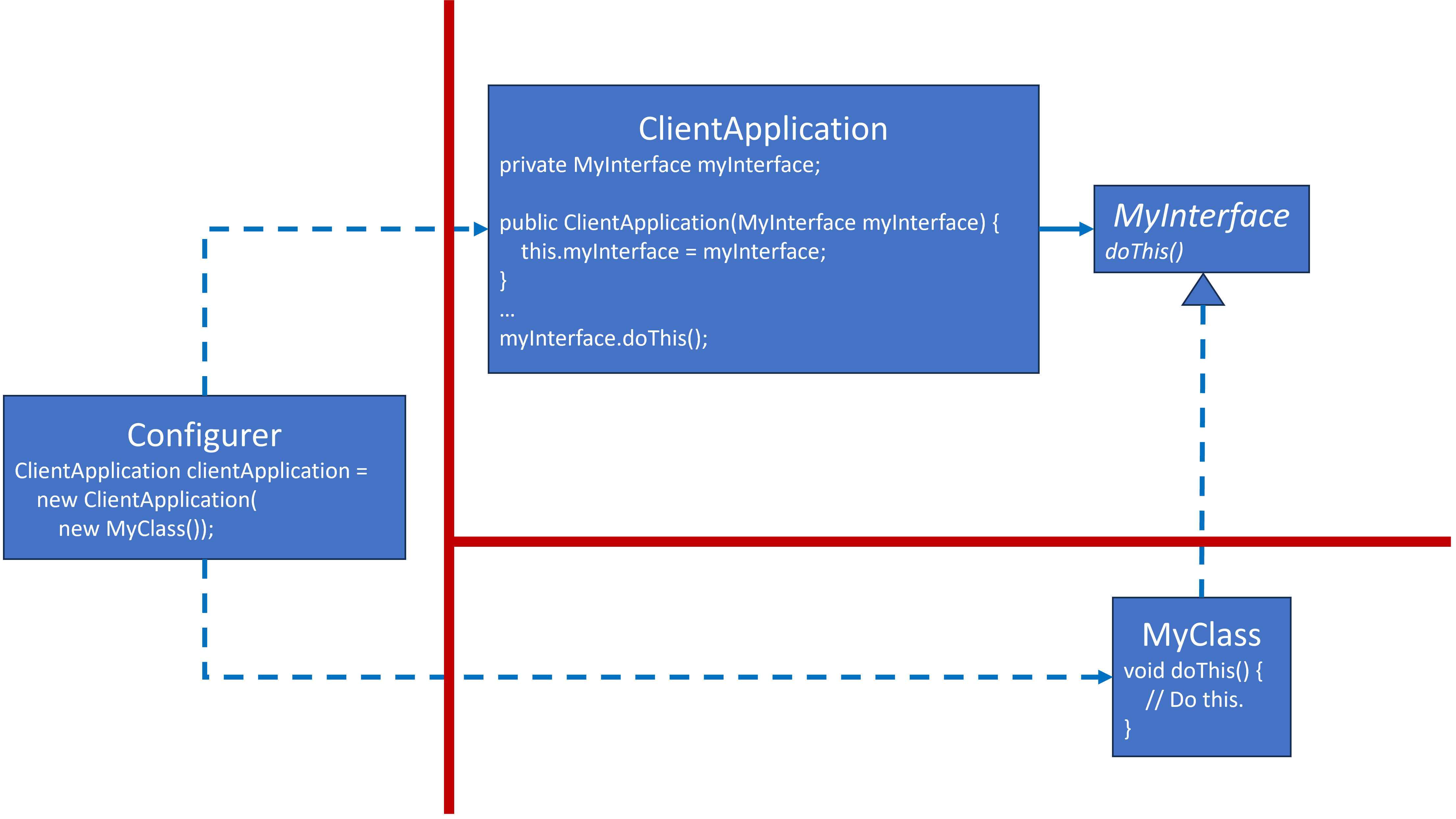
And here’s how I could test the Exception case. I would not have needed to change any existing code. I only needed to introduce MyTestDouble and TestConfigurer, which doesn’t affect the previous design. ClientApplication and MyInterface are untouched. MyClass does not appear in this design, but that’s okay. I’m not interested in MyClass for this test. I’m only interested in how ClientApplication response when a call to MyInterface throws an exception.
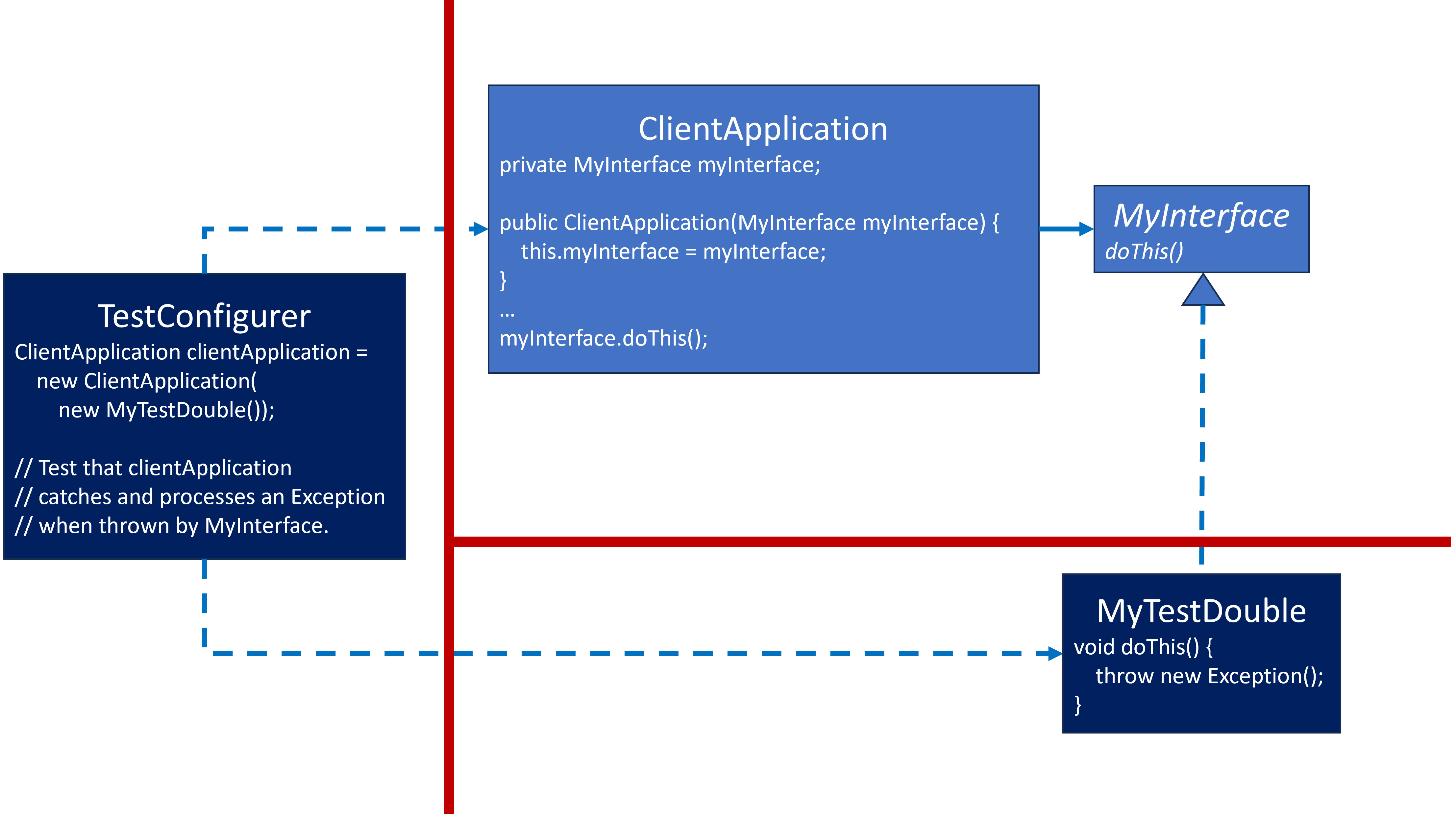
There’s a lot in both diagrams. I need to clarify some details.
MyInterface and ClientApplication
MyInterface is the same in all these diagrams in this blog. It’s an interface contract. It has no external knowledge of how it’s used or how it’s implemented.
ClientApplication is almost the same. The only difference is that the object reference to MyInterface is injected into it via a constructor argument/parameter. This breaks the dependency that ClientApplication had upon MyClass and MyTestDouble in the previous diagrams. Now, it only depends upon MyInterface. ClientApplication will rarely change in subsequent diagrams.
Configurer?
Configurer? It’s not a real word. I made it up. I prefer Orchestrator but it’s too close to Orchestration, which has other meanings. I considered Dependency Injector or Injector, but that’s an implementation technique. I want to convey design intent. Martin Fowler used the term Assembler in Inversion of Control Containers and the Dependency Injection pattern, but that’s a term that used elsewhere too.
I have finally settled on the term I used many years ago when presenting Design Patterns Lunch & Learn seminars at the office. Configurer appeared in many of my Lunch & Learn Design Pattern diagrams, often as an external actor. I’m resurrecting it for these blogs too. The concept rarely appears in the Gang of Four diagrams. This is another sin of omission in their book in my humble opinion.
Red Lines
The red lines are design/architectural boundaries, and they convey the same intent as seen in Factories: Abstract Factory. They constrain the flow of knowledge in a design.
I could go deep into the implications of knowledge boundaries and arrows, and I may go into more detail a future blog (See: Hexagonal Architecture - Why It Works), but I’ll try to highlight what’s important now:
ClientApplicationandMyInterfaceare isolated in the upper right quadrant of this diagram. All class relationships cross the red boundary pointing inward. These entities have no knowledge or dependency upon other elements of the design. The rest of the design is invisible to them.ConfigurerandTestConfigurerare on the far left of the diagram. All class relationships cross the red boundary pointing outwardly from these classes. These elements have knowledge and dependency of the entire design, but they restrain themselves. They only use this knowledge to create and configure the objects in the rest of the design. They don’t contain any business logic. Not only are Configurers invisible to the rest of the design. They are invisible to each other as well. This design supports as many Configurers as needed.MyClassandMyTestDoubleare in the lower right quadrant of this diagram. They have knowledge of and depend uponMyInterface. They tend to be small, and they are often Adapters or Façades. Only theConfigurerknows about them, so they can be swapped out easily as needed.
Turtles All the Way Down

But wait a second! Configurer is instantiating MyClass via new(). What happened to those Factories Design Patterns from the previous blog post?
I had two mental blocks with Dependency Injection when I first started to read about it:
- Was I still going to have to inject all dependencies for production and unit testing?
- Where does it end? We’re not kicking the can down the road anymore so much as we’re kicking it under the rug, which really isn’t a very good metaphor.
The Complete Set of Dependencies
Was I still going to have to inject all dependencies for production and unit testing?
Short answer: Yes and No.
Production configuration will require resolution for all layers of dependencies, even dependencies of dependencies. This might get a bit large and complex, but it’s only creating instances and assembling them together. An understanding of the parts of the architecture is needed, but there is no business logic.
Here’s an example where:
ClientApplicationdelegate toInterface1Implementation1implementsInterface1, and it delegates toInterface2andInterface3Implementation2andImplementation3implementInterface2andInterface3respectively.ProductionConfigurercreates and connects the dependencies as follows:
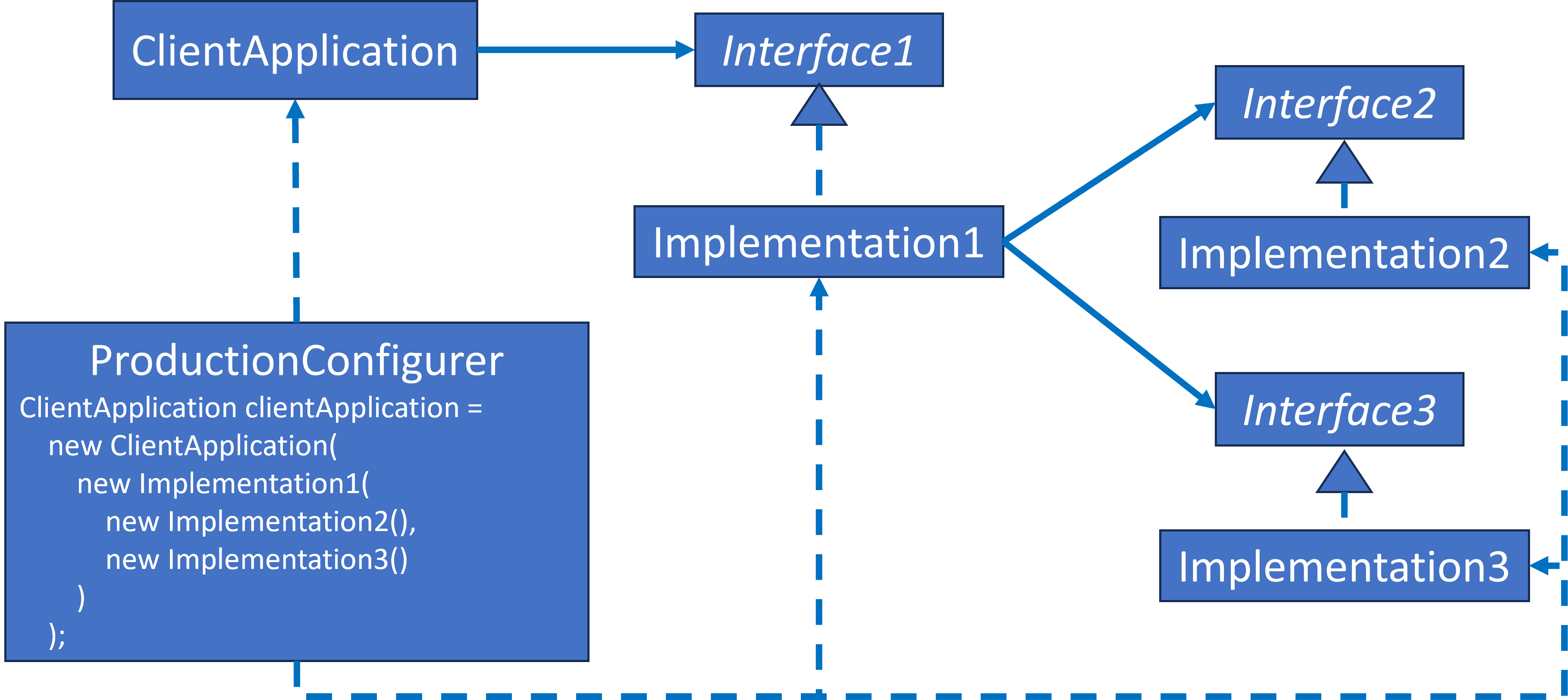
We can see that ProductionConfigurer is creating an instance of ClientApplication by creating instances of its dependencies and injecting them as constructor arguments. The developer who implements ProductionConfigurer will most likely be an architect or team lead. It’s more important to have knowledge of the overall design than it is to have specific knowledge about any of the individual classes.
ProductionConfigurer is not limited to calling new directly. Here are a few other options:
ProductionConfigurercould create and inject using Factories Design PatternsProductionConfigurercould be based upon an inject framework, such as Spring described below- If configuration is more dynamic or configurable, then
ProductionConfigurercould leverage the Builder Design Pattern.
Unit test configuration will require resolution for the first layer of dependencies only. The interface is a contract. It is not an implementation. Implementation knowledge and dependencies are encapsulated behind it. It doesn’t matter how simple or complex the actual implementation is. We only need to configure the bare minimum in our Test Doubles, and that may only be a single behavior for a single method too.
Here’s how we could test ClientApplication in isolation with Test Doubles:

Notice how all the Implementation classes and their interfaces are not present, except for Interface1. And Interface1 is only shown, because ClientApplication depends upon it. This is part of the elegance of Program to an interface, not an implementation.
The dependency chain stops at Interface1. There is no dependency upon Implementation1 even if Implementation1 will implement Interface1 in production as was shown in the previous diagram.
Even if the production configuration requires multiple layers of dependency, we only need to configure one layer at a time for testing.
Here’s how we could test Implementation1 in isolation with Test Doubles:
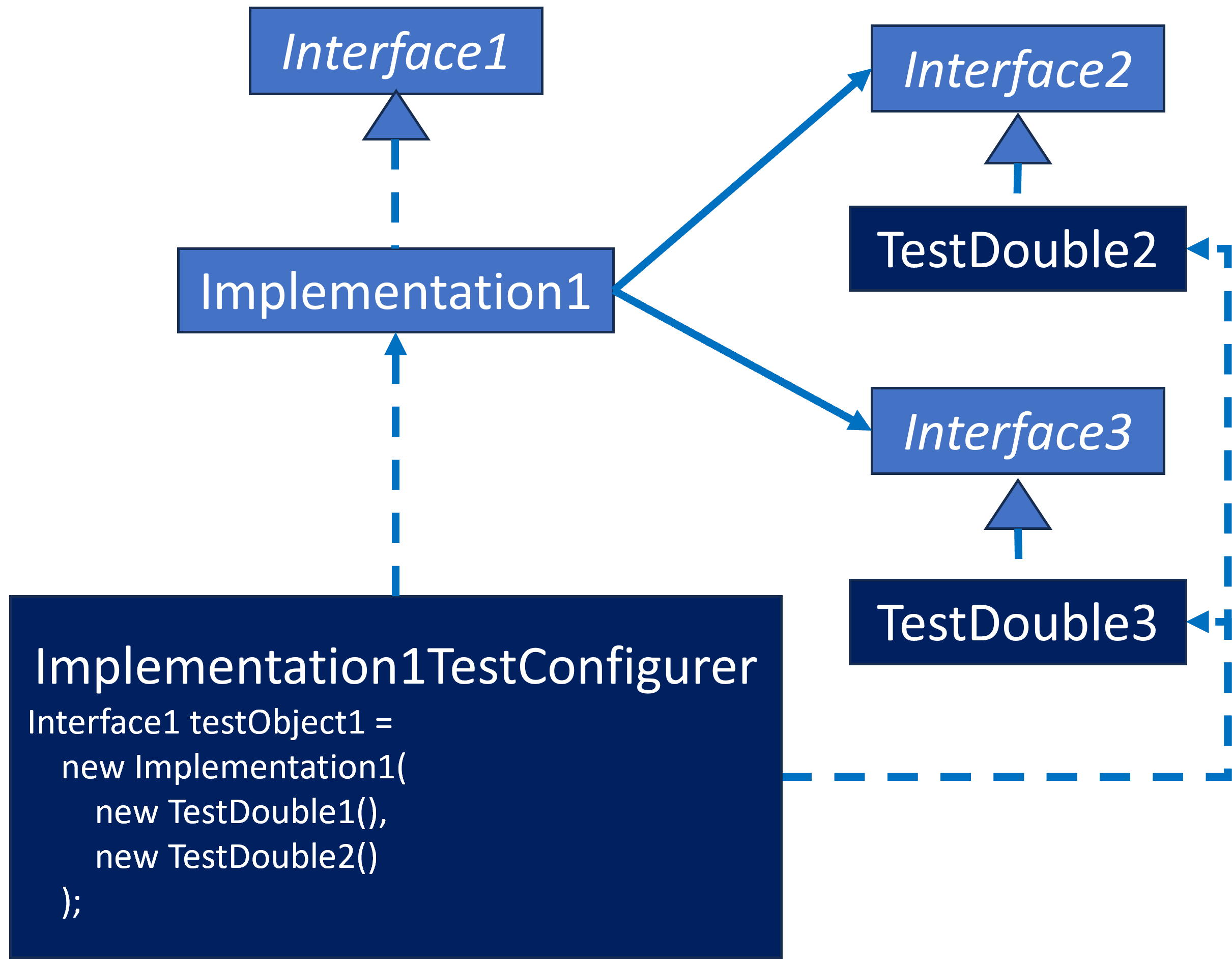
And like the previous diagram, we only need to configure one layer to resolve the dependencies.
Kicking the Can Under the Rug
Dependency Injection is a Creational Design Pattern, even if it wasn’t included by the Gang of Four. I don’t think this was a sin of omission as much as it was a case of DI not being too well known when they were writing their book.
I think it’s okay to resolve object references via new via DI, but we’ll soon see that we can use Factories with DI as well.
I think there’s another reason why new() is okay in Configurers. Bob Martin talks about these boundaries in Clean Architecture:
- The upper right quadrant is cocooned business logic. It has no concrete external dependencies. All communication to external dependencies is via interfaces
- The lower right quadrant contains the concrete dependencies. They tend to be small implementations, especially when they are Adapters or Façades.
- We are kicking the can under the rug, but we will eventually reach the bottom. The Configurers are in the “lowest” section of your code. They reside in the bootstrap portion of the feature, possibly
main(). It’s so “low” in the code that you can usenew()and not get yourself into too much trouble.
Dependency Inject and Factories
While we can call new() using DI, we can still use Factories with them as well.
Here’s one example:

As for the Exception set up, it would be identical to the Exception Test UML class diagram shown above. There’s no need for a Factory in that test.
And here’s how DI can work with Abstract Factory:

Here’s the Exception Test diagram:
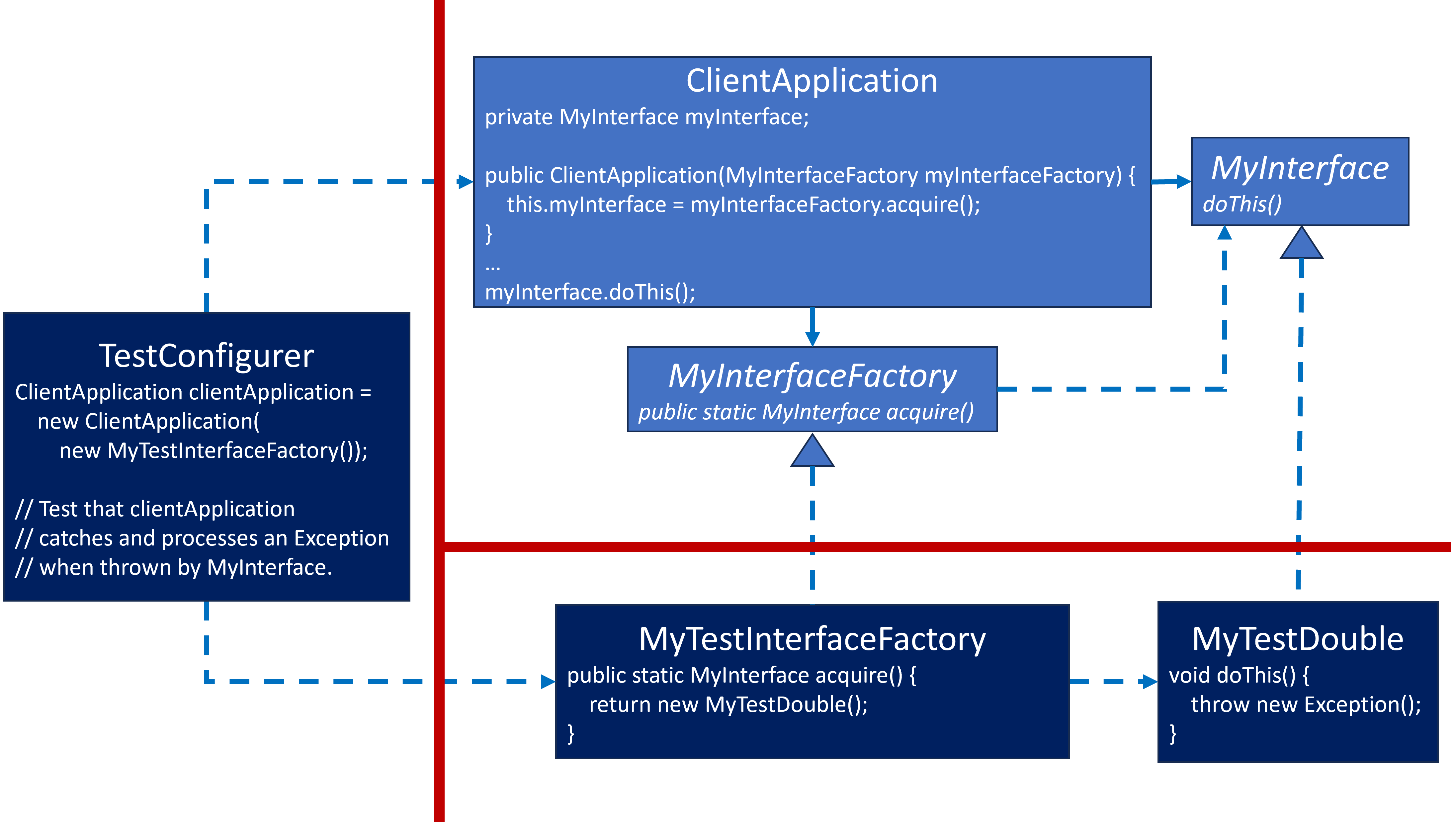
Spring
There are Dependency Injection frameworks as well, with Spring probably being the most well-known for Java. It’s very similar to what I’ve shown previously, except that there are a few annotations. As for that Spring Magic, that’s part of the Spring framework. It will handle everything you need if what you need resides in the framework. You won’t have direct access to the Spring Magic itself. For the most part, you don’t even see it.
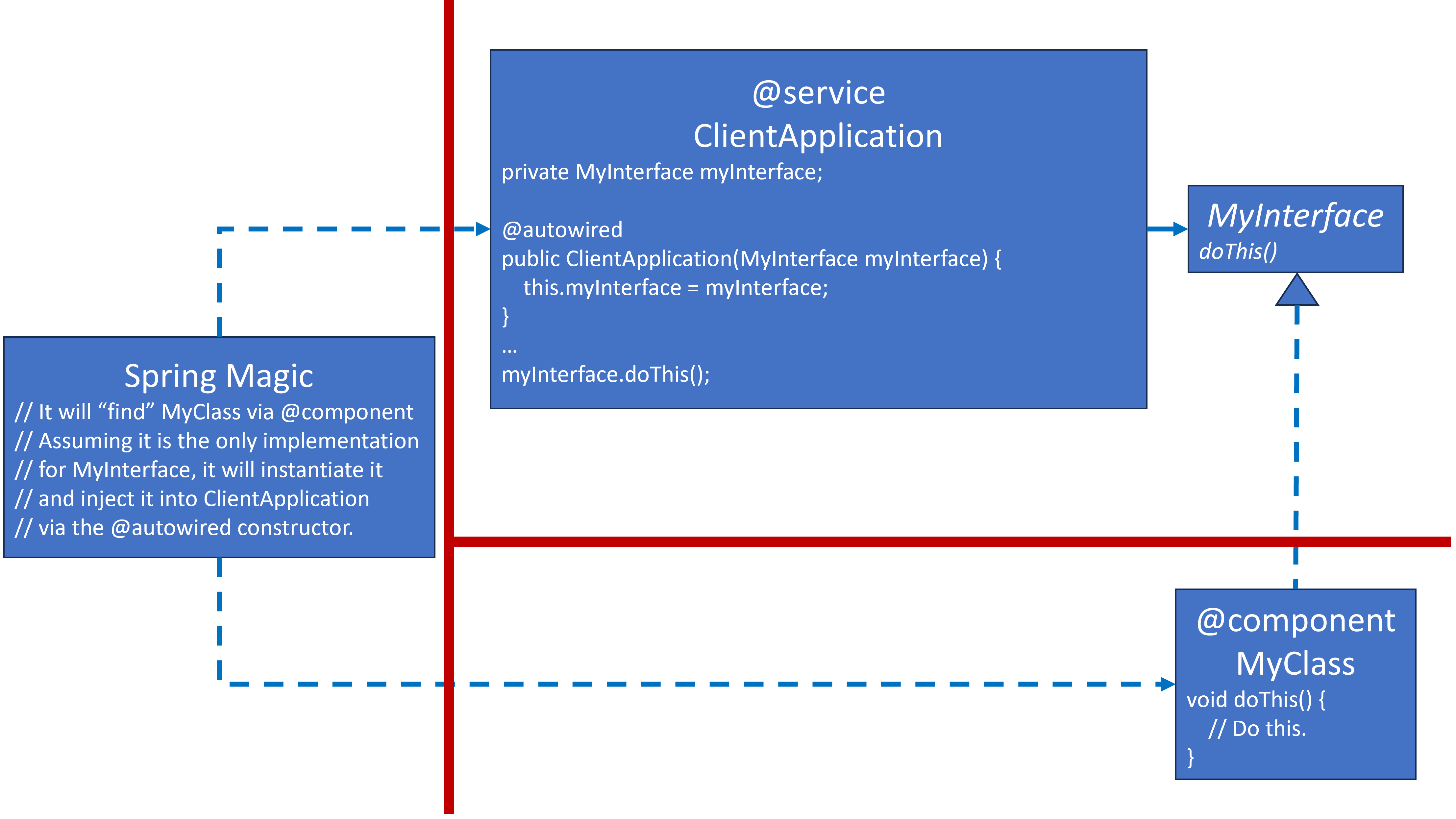
You have at least two options with testing, and they will be very similar to what we’ve seen above. I’ll describe them without providing additional images:
- It’s no different than the test designs shown before. Even with Spring annotations, they are still Java classes. A Test Double can be created and injected when an object instance of
ClientApplicationas its constructor argument when created vianew(). This can be done in the test code without depending upon the Spring framework. - JUnit can create Test Doubles via Mockito with Spring (and also without Spring), to inject what’s needed as well.
Dependency Injection vs Dependency Inversion Principle vs Inversion of Control
These are three concepts with similar names and similar concepts, but still different:
- Dependency Injection is a design pattern/technique that injects dependencies into a class, usually as a constructor argument.
- Dependency Inversion Principle is not allowing a class to have any knowledge or dependency upon a class that it delegates to.
- Inversion of Control is how frameworks work. The inversion is that the framework calls your code.
Summary
Dependency Injection feels a little strange at first glance, but it’s a useful way to resolve dependencies while maintaining flexibility in the design. This wraps up the Essential Design Patterns.
References
Here are some free resources:
- Dependency Injection:
- Wikipedia
- Inversion of Control Containers and the Dependency Injection pattern by Martin Fowler
- A Practical Introduction To Dependency Injection by Jamie Corkhill
- Java Dependency Injection - DI Design Pattern Example Tutorial by Pankaj
- Guide to Spring @Autowired by Baeldung
- Dependency Inversion Principle:
- Inversion Of Control:
- Wikipedia
- Inversion of Control by Martin Fowler
- Intro to Inversion of Control and Dependency Injection with Spring by Baeldung
Here are some resources that can be purchased or are included in a subscription service:
- API Design in C++ Chapter 3 by Martin Reddy (O’Reilly and Amazon)
- Clean Architecture Chapter 11 by Robert Martin (O’Reilly and Amazon)
